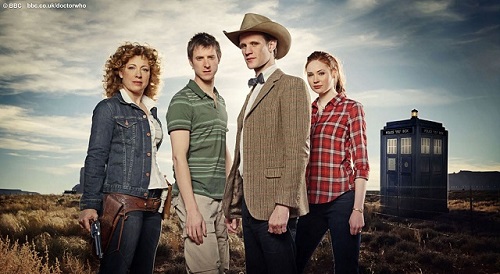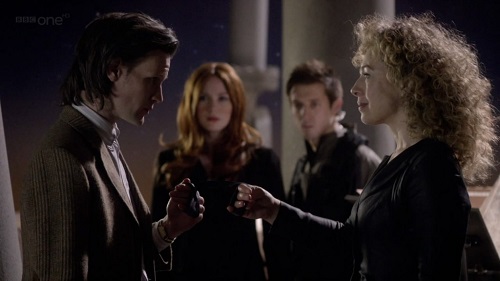
Part of that process was figuring out how to use the Companions as part of the story. Their initial position within the series was unclear. When the show began, it often seemed like original Companion Ian Chesterton (William Russell) was the real star of the show, while The Doctor (William Hartnell) was a mischievous and mysterious figure who was more a McGuffin on the road to adventure than a hero seeking wrongs to right. For a while, it seemed like the adventures of Ian, his fellow teacher Barbara, and The Doctor’s granddaughter Susan might make for a decent TV show without the grumpy old man getting in the way and mucking things up.
Ian and Barbara are essential Companions not just for the way they laid out the template for that role, but because of how they shaped The Doctor as a character. He develops over their time in the TARDIS from a gruff, curmudgeonly non-interventionist into a kind, gentle warrior for all that is good and just. He also develops into the clear center of the show, shifting from being a figure of intrigue into a man worth rooting for and worth following to the furthest reaches of space and time.
 What makes the early show work is the strong family dynamic the core cast forms. Ian and Barbara (who are clearly romantically linked by some point in their run, though the show never comes out and says this) act as a sort of mother and father, trying to educate, nurture, and show the child on board the right way to live. The Doctor serves as the grandfather, a figure of mischief, and occasionally a curmudgeon, who is generally willing to scheme with first his granddaughter and then her stand-in to pull one over on “Mom” and “Dad”
What makes the early show work is the strong family dynamic the core cast forms. Ian and Barbara (who are clearly romantically linked by some point in their run, though the show never comes out and says this) act as a sort of mother and father, trying to educate, nurture, and show the child on board the right way to live. The Doctor serves as the grandfather, a figure of mischief, and occasionally a curmudgeon, who is generally willing to scheme with first his granddaughter and then her stand-in to pull one over on “Mom” and “Dad”
Though Susan never really works as a character (for reasons that could make for a completely different article), her replacement, Vicki, cements what the show was going for in this period. The run of episodes featuring The Doctor, Ian, Barbara, and Vicki is the strongest period during Hartnell’s tenure in large part because they form a surrogate family with an ease and chemistry that makes them resonate as real characters. The Doctor softens enough to truly care about Ian and Barbara and comes to be incredibly fond of Vicki as well. Ian and Barbara grow into being something more than just colleagues, and Vicki, an orphan who the group find marooned on an alien planet, is in need of a new family. Together, they create a dynamic that could easily have become the new normal for the series: The Doctor, two parent-figures, and a young person to stand in for the audience.
Except it didn’t. After Ian and Barbara depart, The Doctor spends the entire rest of the original series’ run gallivanting around the universe with a bunch of young, attractive companions (and keeps getting younger himself, with most regenerations handing the role off to a more youthful replacement). Until, of course, The Eleventh Doctor (Matt Smith). During his tenure, for the first time since Hartnell, The Doctor travels with a romantically linked couple and, eventually, their daughter.
 Like Ian, Barbara, and Vicki before them, these three are inarguably the quintessential companions for their Doctor: Amy Pond, Rory Williams, and River Song. Things have changed in the half century since their most direct predecessors, but a lot has remained exactly the same. For one thing, the greatest success of this grouping is the way they develop a strong family dynamic; they all feel like they belong together whereas a single companion can occasionally feel like a space holder to keep The Doctor from talking to himself. They also grow over the course of their time together from being somewhat tense and estranged to operating like the best of friends, a team that is more than a team, a family that would die for each other if necessary.
Like Ian, Barbara, and Vicki before them, these three are inarguably the quintessential companions for their Doctor: Amy Pond, Rory Williams, and River Song. Things have changed in the half century since their most direct predecessors, but a lot has remained exactly the same. For one thing, the greatest success of this grouping is the way they develop a strong family dynamic; they all feel like they belong together whereas a single companion can occasionally feel like a space holder to keep The Doctor from talking to himself. They also grow over the course of their time together from being somewhat tense and estranged to operating like the best of friends, a team that is more than a team, a family that would die for each other if necessary.
The biggest differences involve what Doctor Who can come out and say in the 21st Century that it could not in the 1960s. Amy and Rory are openly a couple from Day One. They get married, their sexual relationship is alluded to from time to time, and they eventually even have a child. Beyond that, River is a Companion like no other in that she and The Doctor are openly involved as well. Though it takes some time for the two to get on the same page (because both are time travelers, they are never exactly sure at which point in the other’s timeline they are meeting), eventually they become lovers (or the closest the show will ever let The Doctor get) and even, arguably, get married.
When River turns out to be Amy and Rory’s daughter this revelation throws a lot of fun wrinkles into the various relationships, both because Amy and Rory have gotten to know her as an adult before they ever even conceived a child and because they know her first as a romantic interest of The Doctor and only later as the child they never had the chance to raise. Eventually, though, the four are bonded together into a complex family unit that faces each threat together, bickering and bantering as they go.

It’s easy, when The Doctor has only one Companion, for that character to be swallowed up until they are little more than an audience surrogate, a wall for The Doctor to bounce exposition off of and a character to get captured when the show needs The Doctor to save someone. Yet the family unit allows for far more dimensions in each of these situations, keeping things from getting stale and also reminding the writers to make sure the Companions are characters rather than plot devices. Plus while The Doctor clearly loves humanity as a whole, it isn’t always obvious that he loves people as individuals. The Doctor is, even now, a gruff, blunt, sarcastic, and occasionally cruel being. What grounds him is his constant connection to a Companion, and when that connection is multiplied, it allows The Doctor’s complex relationship with humanity as a whole and in its individual formations to crystallize.
Think of the way Eleven flirts with River, bickers with Amy, and tries to form a bro-mance with Rory (made all the more enjoyable because neither of the two particularly fit within our definitions of traditional masculinity). His relationship with each of these characters feels real and it deepens our understanding of him and the way he relates to the world. Combine them all, and you see The Doctor as a fuller character.
At this point, The Doctor has been traveling the cosmos for almost 1000 years and it is well established that often, it’s lonely out in space. Surrounding him with a surrogate family both alleviates that loneliness and makes him ruminate on the reasons he keeps running, even though he often causes harm, even though he loses everyone he travels with, even though people die. The Doctor needs people, to be sure. But he needs more than that. As these two groupings have shown, from time to time, The Doctor needs a family. It may just bring out the best in him. A lot has changed in the past 50 years, but one thing, at least, has remained the same: The Doctor is a family man at heart, a creature longing for companionship in a vast, cold, and unforgiving universe, who occasionally finds a group of people that remind him why he keeps going after all these years, and why we keep following him.
Jordan Ferguson

